
Background information
Drone, crash and mails: disaster follows disaster
by Livia Gamper

To ensure the safety of traffic in the surrounding airspace, air traffic controllers use high-tech navigation, radio and radar systems. But human communication and control are even more important than all these instruments.
At first glance, there are only monitors, whole rows even. The radio is loud. All I understand at the end of a pilot's radio communication is "Hi". There are currently four air traffic controllers working in the tower. "At peak times, there are five," explains Vladi Barrosa, spokesman for skyguide Zurich. The controllers work in shifts. A controller never works more than two hours without a break, for a total of seven hours a day. In the tower, there are therefore six rotations a day.
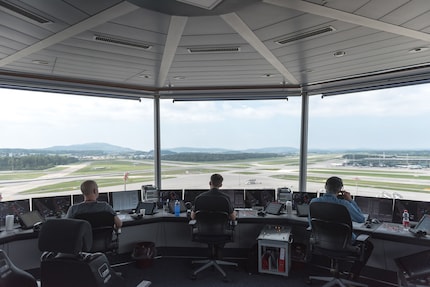
According to Vladi, the air traffic controller's main task is very simple, "to prevent collision on the ground and in the air, that's all."Air traffic controllers use a wide variety of technologies to control the complex flow of flights. So they don't do the same thing all day long. Each of the four or five air traffic controllers in the tower has a different job.
Christoph, seated on the far left, is in charge of ground clearances, the famous "clearance deliveries", i.e. aircraft still at the gate. Once the aircraft doors have been closed by the cabin crew and the plane is ready for take-off, Christoph calls the flight deck by radio to inform them of the weather and the latest details about the flight itinerary.
Then Christoph uses the radio to call the flight deck to inform them of the weather and the latest details about the flight itinerary.
Then Christoph calls the flight deck to inform them of the flight itinerary.
Then Christoph uses "Squawk" or "Display" to assign a transponder code, a four-digit code that identifies the transponder with which each aircraft is equipped. The pilot sets the code assigned to him in his system. The transponder code is used to identify the aircraft later on the air traffic control radar screens. The radar sends a pulse to the aircraft's transponder. The transponder responds and is displayed with the recognition code on the radar screen.
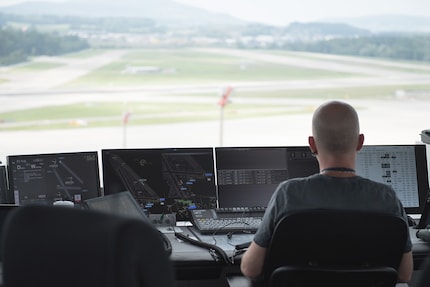
Thanks to the transponder code, air traffic controllers can read the flight number, altitude and speed of the aircraft. There are also specific transponder codes. If an aircraft is in an emergency situation, the pilot must change the code. For hijacked aircraft, for example, "Squawk" is 7500.
In the tower, Xandel, who occupies the middle seat, explains to me in his Austrian dialect that he is in charge of ground control. What matters to him is what happens on the airport tarmac. He is also responsible for a number of other tasks, including coordination between Dübendorf and Zurich airports. Rega's military aircraft and helicopters take off from Dübendorf. The take-off of military aircraft also requires the intervention of the tower. Military and rescue aircraft have priority over passenger aircraft departing from Zurich.
Let's say Rega had to fly over the Zurich airport area as part of an emergency, commercial aircraft would then have to wait. The same goes for a military aircraft. If this is the case, "Dübendorf calls", Xandel explains. "I'm surprised that communication is by telephone and radio, and that there are even dedicated lines to other airports. I was expecting data to be transmitted using slightly more high-tech means. Admittedly, the system is a complex telecommunications network controlled by a touch screen. But I'm surprised that an air traffic controller has to pick up the telephone handset as well as the radio.
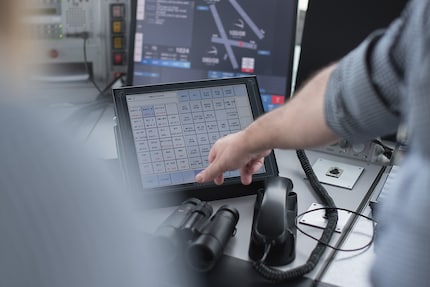
As well as coordinating with Dübendorf, Xandel, in its role as Ground Control, is also responsible for lighting the runways, the beaconing as it is known in the jargon. Control of the light beacons - switching on, off, individual selection - is carried out from the control tower.
Stop bars - the most important red beacons - are located at the intersection of each take-off or landing runway. For pilots, it's like a red light. They can only cross the runway after receiving the green light from the air traffic controller.
Runway lighting has to be adapted to suit the conditions: night, snow, rain and fog. I ask Xandel what method he uses to light the beacons. "Generally, I just have to look out of the window."
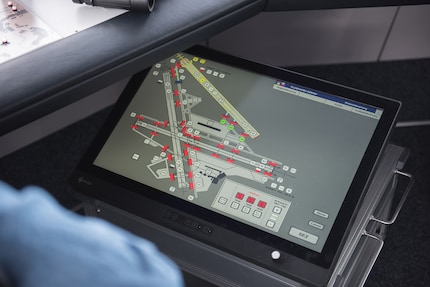
Like all air traffic controllers at Zurich Airport, Xandel works not only in the airport tower, but also at the area control centre in Dübendorf, also known as the Area Control Centre (ACC), in charge of approach control. In these roles, they direct arrivals and departures to and from Zurich airport.
I ask the air traffic controllers where they prefer to work. They all agree that the missions in Dübendorf are more interesting than those in the tower in Zurich. "There's more going on," says Xandel. I thought that the incessant ballet of planes taking off and landing would be enough for them. Xandel sees my astonishment and adds: "In Dübendorf, I have a lot more influence than when I work in the tower," he explains. That's because everything there is regulated and very restricted. In Dübendorf, on the other hand, the air traffic controllers can work more dynamically and have more freedom. They transmit flight altitudes as well as flight, climb and descent speeds. What's more, in bad weather, aircraft often do not follow the course set by the controllers. "Everyone does a bit of what they want," Xandel quips.
Sitting next to Xandel, Stefan, airfield controller, hasn't taken his helmet off since I arrived in the tower. He coordinates aircraft for take-off and landing and gives pilots permission to take off, land and cross runways.
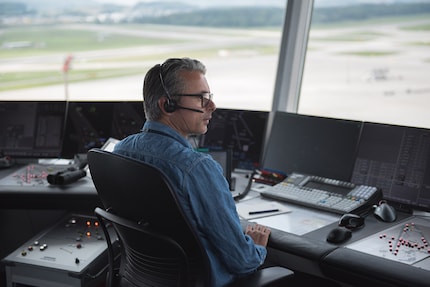
Furthermore, Stefan doesn't for a second let go of the airport radio frequency to respond to incoming radio messages from pilots. Stefan shows me an Edelweiss aircraft standing on the runway threshold. It's cleared for take-off. Stefan mentions the name of the aircraft, not forgetting the strength and direction of the wind, then calls out "Cleared for takeoff". The plane takes off on the runway and reaches its rotation speed at the height of the tower. He's flying to Costa Rica," laughs Stefan.
Then he addresses the pilot again: "Contact departure", which means for the pilot that he must now change the radio frequency. The frequency is recorded in the aircraft's flight management system, but the change of frequency is done manually by the pilot. This then passes to the controllers in Dübendorf. The control tower at Zurich airport is only responsible for the very first phase of an aircraft's take-off.
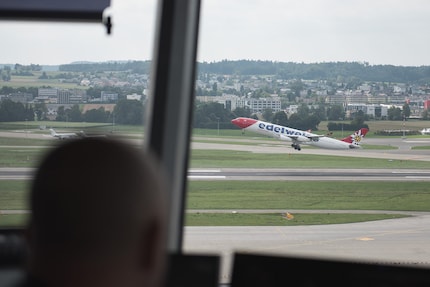
For landing, the situation is intended to be different. When an aircraft arrives within 20 kilometres of the airport, it must contact the tower. For the approach procedure, it lines up in an air corridor and then receives landing clearance from Stefan. "Clear to land, runway one four," Stefan says over the radio, meaning that the plane can now land on runway 14.
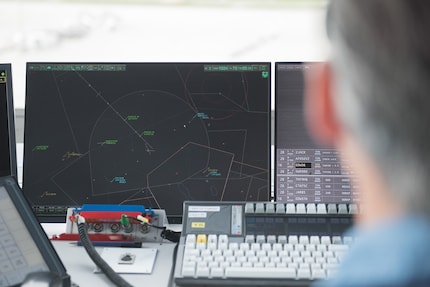
Runway 14, which adjoins Dock E, is behind a copse of trees. We can only see the aircraft when it is taxiing along the runway. Vladi Barrosa explains to me that this grove - a protected nature reserve, pruned only twice a year - obstructs the view of the marshallers, which is a source of problems. When the trees are a little higher, the controllers can no longer see the runway. That's why, for about two years now, a screen linked to a live webcam filming runway 14 has been placed above the monitors in the tower.
"A few years ago, a plane veered off the runway," explains Vladi. "Because of the height of the trees, the signalmen only noticed it when they saw people going along the runway. Hence the presence of this camera."
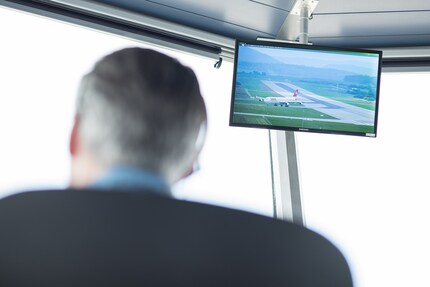
But Stefan doesn't just direct the planes by looking out the window at the runway. Ground radar information for all runways and approaches is displayed on one of his four screens. Like the planes, all the cars and buses travelling around the airport are fitted with transponders. All the vehicles in the airport appear on Stefan's radar screen. An installation located in Dock E generates a radar image.
Another of Stefan's screens shows the airport's cross-track configuration. As take-off and landing are always into the wind, wind direction and strength are displayed on this screen. On the next monitor, Stefan sees the current flight plan. All departing flights are displayed on the left half of the screen, all approaching flights on the right half.
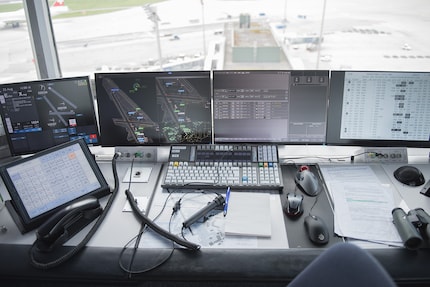
On the Holberg, just outside Kloten, are the two radar systems that generate the images for monitoring arrivals and departures. The two systems are redundant, i.e. double. In the event of a radar failure, it is not necessary to immediately interrupt all air traffic. However, operations are reduced for safety reasons. "Radar technology dates back to the Second World War, the very latest," laughs Vladi. However, the interaction with the new installations and systems is working. A more recent radar as well as a radio installation can be found at Lägern Hochwacht.
Despite the three different radar systems and numerous displays, the most important one, i.e. take-off and landing clearance, is controlled by the air traffic controllers and broadcast exclusively by radio on the VHF bands.
There are now high-tech systems that allow air traffic controllers to enter instructions for the pilot in the cockpit in text form. Only installed on the most recent aircraft, this system is called CPDLC (Controller-Pilot Data Link Communications), a technology that won't catch on in the tower, switchers explain to me, because transmission times there are simply still too long.
The system is called CPDLC, which stands for Controller-Pilot Data Link Communications.
On the radar, Stefan can identify all the aircraft flying over Swiss airspace by zooming out. As everything is visible on the radar, I'm surprised that there's a pair of binoculars at each station. Vladi explains to me that they need them when a drone gets lost in the air around the airport or to locate objects to be removed from the runways.
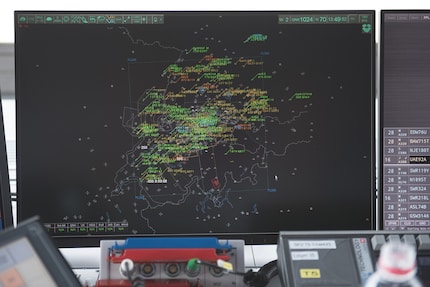
Drone overflights are banned within a five-kilometre radius of the airport. Despite this, it's not uncommon for some to get lost. As drones are not visible to the naked eye from a distance, air traffic controllers need binoculars. There have been occasions when controllers have received a radio message from pilots on approach to report the presence of a drone in their flight path. The controllers then have to inform the police from the tower," Vladi explains to me.
To remedy this situation, Skyguide and the company AirMap have developed an air traffic management system for drones called U-Space, enabling air traffic controllers to warn drone pilots in real time when their machines find themselves in the path of an aircraft. The drone's GPS data can then be detected on the radar. To fly a drone, all you have to do is register with the system to receive digital authorisation to access the airspace. This system is already being tested in Lugano, where air traffic controllers have an additional radar screen for drones. In Zurich, drones still have to be located using binoculars.
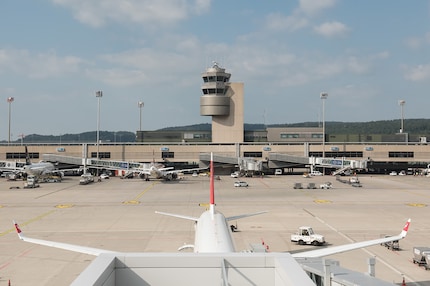
Air traffic controllers work with radar systems that are both old and state-of-the-art. That said, the most important part of their job is communication and self-control. They are fully responsible for flight safety. I'm surprised to see that they are still so dependent on radar and binoculars, and that tools like CPDLC have not yet made their mark. After all, isn't it said that the best is the enemy of the good?
As flight operations at Zurich airport come in waves, traffic is increasing again. As far as I'm concerned, it's time to leave the control tower and let the air traffic controllers get on with their work.
As air traffic operations at Zurich airport continue in waves, traffic is increasing once again.
Testing devices and gadgets is my thing. Some experiments lead to interesting insights, others to demolished phones. I’m hooked on series and can’t imagine life without Netflix. In summer, you’ll find me soaking up the sun by the lake or at a music festival.
Interesting facts about products, behind-the-scenes looks at manufacturers and deep-dives on interesting people.
Show all